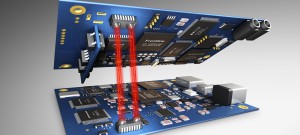A distinguishing feature of industry 4.0 is the large amount of data generated when production processes are linked. Previously, data streams were sent primarily by cable, but this method is cumbersome when used in industrial processes and the cables are also prone to wear and tear. Transferring data using a wireless LAN is not a viable alternative because it is not fast enough. To solve this problem, engineers at the Fraunhofer Institute for Photonic Microsystems IPMS have developed a module that transmits data rapidly and securely using infrared light. Industry 4.0, as it’s known in Germany, has already been introduced into many industrial production processes. Companies no longer want mass production; they prefer small-batch or customized fabrication. The manufacturing environment of the future requires decentralized processes with production chains that are continuously monitored via machine-to-machine communication. In this setup, sensors, machines, controllers and regulator units communicate with each other while exchanging enormous amounts of data. This type of data transfer used to be carried out almost exclusively with cables, since RF-based data transmission via wireless LAN is too slow, inefficient and vulnerable to radio network disturbances and unauthorized access. But as demand for higher data rates, more robustness, lower energy consumption, better data security and interconnectivity grows, the need to exchange data in a wireless way is growing as well. The Fraunhofer Institute for Photonic Microsystems IPMS in Dresden is working on technologies that transmit data via infrared light. Such systems can already achieve transmission speeds of up to 12.5 gigabits per second over short distances, and up to 1 gigabit per second for distances of up to 30 meters. The main benefit of wireless systems is that they offer greater reliability and security than expensive specialty cables that are prone to wear and tear.
This is of special importance for systems with articulated or moving parts. Using a wireless communication module also means there is no need for expensive retooling or maintenance work – resulting in significant savings in setup and upkeep costs. Researchers on the Optical Wireless Communication team led by Dr. Frank Deicke have developed a plug-and-play communication module that can be easily integrated into existing control systems and machine infrastructures. Based on Li-Fi technology, their transceiver replaces the HF plug connectors (which are prone to wear) in these applications, allowing for improved board-to-board communication. This means high-frequency signals can be transferred faster and more reliably between two circuit boards. Presently, the smallest of these transceiver modules measures a mere 2 x 2 x 2 millimeters in size. The transceiver module is particularly well-suited for industrial applications where large amounts of data have to be transferred at very high speeds, and for which HF connector plugs are no longer suitable for reasons of mechanical robustness and reliability. The transceiver performs just as well as cables or plug connectors do, and it is also up to 10 times faster than current radio-based solutions. Other benefits of infrared transceivers include negligible bit error rates (<10-11), low energy consumption and reduced costs. In addition, infrared data transmission provides better reliability and security. This is because unlike radio waves, the light waves are transmitted only within a limited beam range, so an opaque panel is sufficient to protect against industrial espionage attempts.




